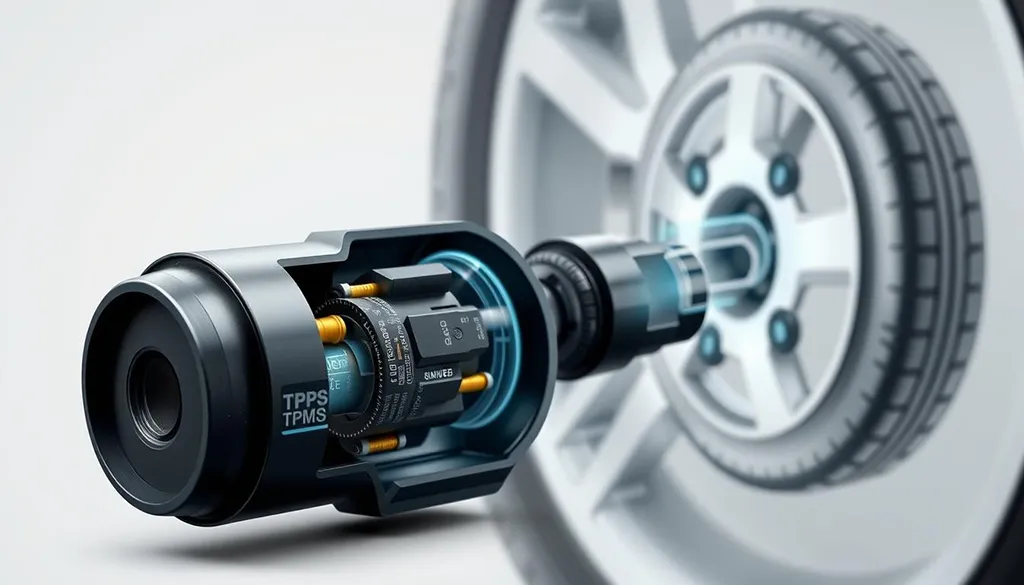Tire pressure sensors are key in today’s Tire Pressure Monitoring Systems (TPMS). They help keep drivers safe by alerting them to tire pressure problems. The TREAD Act made them mandatory in U.S. vehicles sold after 2007.
These sensors have greatly reduced accidents caused by under-inflated tires. Did you know that nearly 11,000 accidents happen each year because of tire tread separation? This is often due to tires not being inflated correctly.
This article will explain how tire pressure sensors work. We’ll cover their types, benefits, and help you choose the best ones on the market.
Key Takeaways
- Tire pressure sensors are vital for vehicle safety and are a U.S. law.
- Direct TPMS gives accurate pressure readings and needs resync after tire changes.
- Indirect TPMS is cheaper but might not be as reliable in all situations.
- Keeping tires at the right pressure can boost your car’s mileage by up to 3%.
- Under-inflated tires lead to many accidents and harm the environment.
- Battery life for direct TPMS sensors usually lasts 5 to 10 years.
- Picking the right tire pressure sensors can make your driving safer, more efficient, and extend your tire’s life.
Introduction to Tire Pressure Monitoring Systems (TPMS)
The Tire Pressure Monitoring System (TPMS) is key to making vehicles safer. It alerts drivers when tire pressure is too low. Low tire pressure can hurt fuel efficiency and increase accident risks.
Starting in late 2007, all new cars in the U.S. must have a TPMS. This shows how important it is for tire safety.
Driving with the right tire pressure can save a lot of money on gas. AAA says it can save up to 11 cents per gallon. This highlights the TPMS’s role in saving money and keeping vehicles safe.
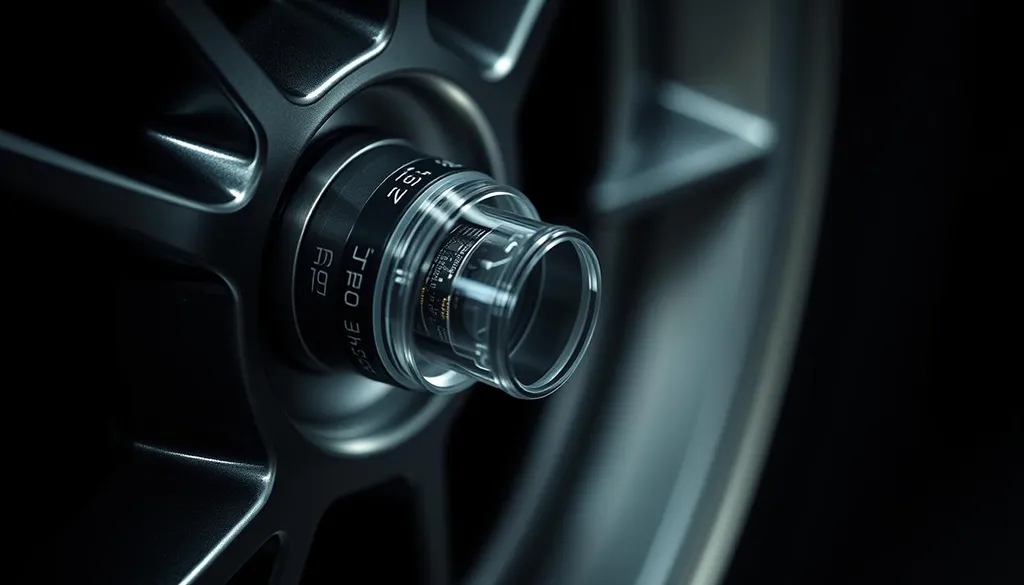
Introduction to Tire Pressure Monitoring Systems
Regular tire care, like inflation and rotation, can make tires last longer. This means safer and more efficient driving. It’s clear that TPMS plays a big part in keeping vehicles running well.
TPMS technology can detect both over- and under-inflation. Checking tire pressure regularly is key. It keeps vehicles running smoothly and saves fuel.
About 25% of vehicles have at least one under-inflated tire. This is a big problem for drivers. TPMS helps prevent many accidents by keeping tire pressure right.
Understanding Tire Pressure Sensors
Tire pressure sensors are key for keeping vehicles safe and running well. They check air pressure and temperature in tires and send updates to drivers. Knowing how these sensors work helps avoid issues and keeps vehicles in top shape.
What are Tire Pressure Sensors?
Tire pressure sensors are part of the Tire Pressure Monitoring System (TPMS) in today’s cars. They watch air pressure and temperature, letting drivers know about their tire health. If pressure is off, the system alerts the driver with lights or sounds.
Types of Tire Pressure Sensors
There are two main types of tire pressure sensors: direct and indirect. Each type has its own way of checking tire pressure:
| Tire Pressure Sensor Type | Description | Advantages | Disadvantages |
| Direct TPMS | Uses sensors inside each tire to measure actual pressure readings directly. | Accurate real-time pressure data, alerts for individual tires. | Requires replacement of batteries every 5-10 years; may be costlier. |
| Indirect TPMS | Utilizes wheel speed sensors to infer tire pressure based on wheel rotation speed. | Generally less expensive, no batteries required. | Less accurate; relies on assumptions about tire pressure from other measurements. |
Importance of Tire Pressure Sensors for Vehicle Safety
Tire pressure sensors are very important for safety. Underinflated tires are much more likely to cause serious accidents. A good TPMS system helps avoid tire blowouts and saves on fuel costs.
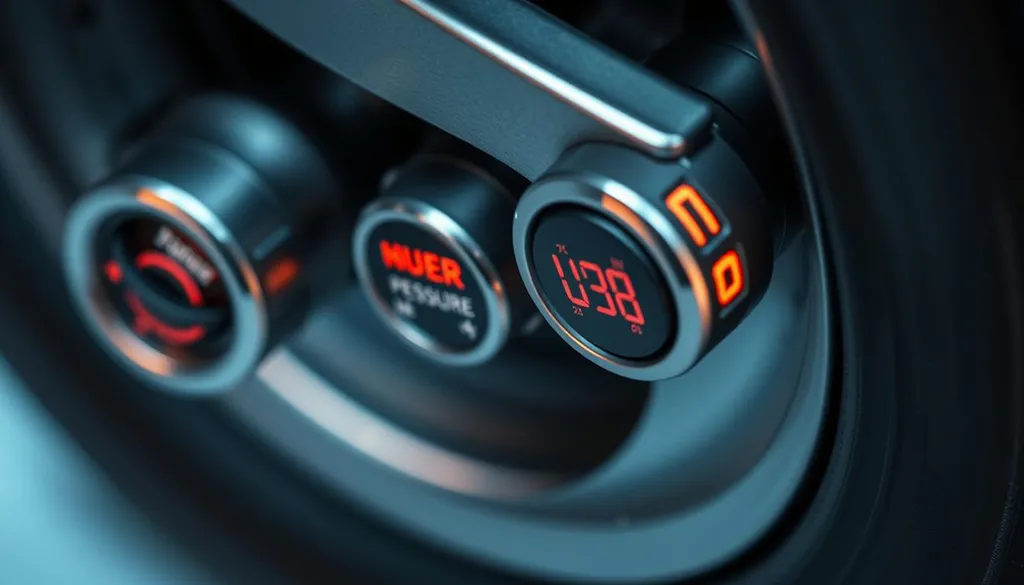
Importance of Tire Pressure Sensors for Vehicle Safety
Properly inflated tires can make your car go further on a gallon of gas. They can also last longer and make driving safer.
How Tire Pressure Sensors Work
It’s important to know how tire pressure sensors work. They help keep your vehicle running well and safely. There are two main types: direct TPMS and indirect TPMS. Each has its own way of working, with its own good points and not-so-good points. Let’s dive into how they work to understand their roles in today’s cars.
Direct TPMS: Functionality and Mechanism
Direct TPMS uses sensors inside each tire. These sensors check the tire’s pressure and temperature all the time. They send this info to the car’s computer right away.
The sensors have a battery that lasts 5 to 10 years. This means drivers get alerts fast if the tire pressure gets too low. It’s a big safety plus.
Indirect TPMS: Functionality and Mechanism
Indirect TPMS works differently. It uses the car’s anti-lock braking system (ABS) to watch the wheel speed. It figures out the tire pressure by looking at how fast the wheels spin.
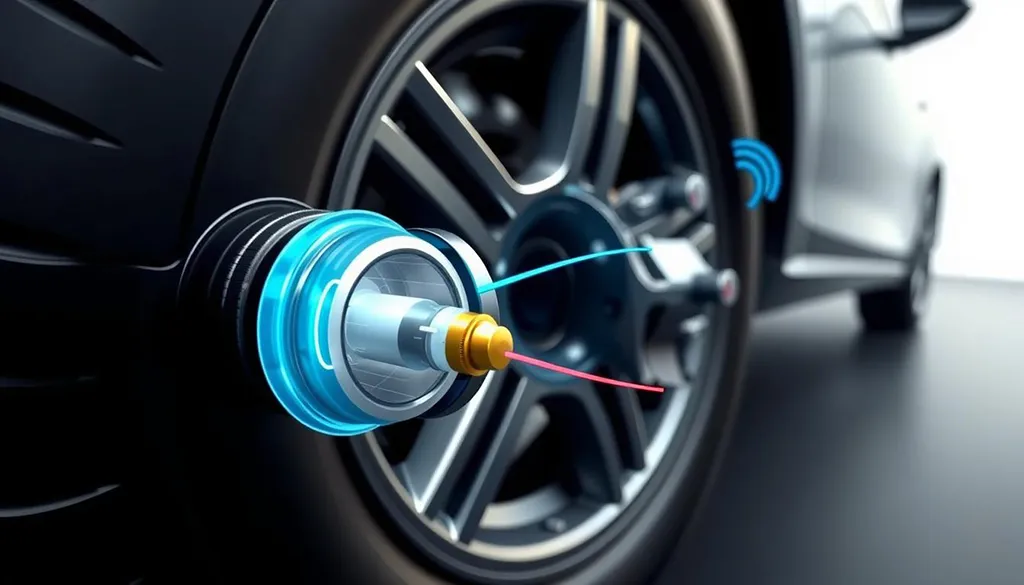
How Tire Pressure Sensors Work
It’s cheaper and needs less upkeep than direct TPMS. But, it might not always get it right. For example, it could get confused if the tires are different sizes or if they all lose air at once.
Comparing Direct and Indirect TPMS
| Feature | Direct TPMS | Indirect TPMS |
| Measurement Method | Measures tire pressure directly and sends real-time data | Estimates tire pressure based on wheel speed discrepancies |
| Cost | Generally more expensive | Typically less expensive |
| Battery Requirement | Requires built-in non-replaceable battery | Does not require additional batteries |
| Maintenance | Requires fewer resets | Often requires resetting after tire maintenance |
| Data Accuracy | Highly accurate readings | Can misinterpret data in specific situations |
Benefits of Using Tire Pressure Sensors
Tire pressure sensors offer many benefits, including better vehicle safety, fuel efficiency, and longer tire life. They help drivers improve their vehicle’s performance and reduce the risk of accidents caused by under-inflated tires.
Enhancing Vehicle Safety
Tire pressure sensors are key to keeping vehicles safe. They warn drivers about under-inflated tires, which can cause accidents like blowouts and flats. With a working TPMS, I can drive safely, knowing my tires are in good condition.
Improving Fuel Efficiency
Tire pressure sensors also help save fuel. Keeping tires at the right pressure can improve gas mileage by up to 3% for every 1 PSI drop. This means I can cut down on fuel costs by simply checking my tire pressure regularly.
Extending Tire Lifespan
Lastly, tire pressure sensors help tires last longer. Proper inflation leads to even wear, which can extend tire life by about 25%. A good TPMS not only boosts performance but also saves money by avoiding early tire replacements.
|
Benefits |
Impact |
| Enhances Vehicle Safety | Reduces risk of accidents from tire failure |
| Improves Fuel Efficiency | Up to 3% gas mileage increase for every 1 PSI |
| Extends Tire Lifespan | Potential 25% longer tire life through even wear |

Benefits of Using Tire Pressure Sensors
In summary, tire pressure sensors are vital for vehicle safety, better fuel efficiency, and longer tire life. They are a must-have for modern car maintenance.
Tire Pressure Monitoring System Sensor Replacement
Keeping your tire pressure sensors in good shape is key for safety and performance. Knowing when to replace them is important. The National Highway Traffic Safety Administration (NHTSA) requires all vehicles made after 2007 to have a Tire Pressure Monitoring System (TPMS). These sensors usually last 7 to 10 years or about 100,000 miles.
When the TPMS warning light comes on, it’s a sign that something might be wrong. It’s important to act fast.
When to Replace Your Tire Pressure Sensors
There are signs that show it’s time for a new TPMS sensor. The TPMS light might blink a few times before staying on, which means there’s a problem. If the light is steady, it means your tires are not at the right pressure. If you see these signs, check your sensors and take action.
If a sensor’s battery dies, it’s best to replace all four. This keeps your TPMS system working right.
Steps for Replacing a Tire Pressure Sensor
Knowing how to replace a tire pressure sensor is helpful. Here are the steps:
- Get the tools you need, like a new TPMS sensor, a valve core tool, and a tire pressure gauge.
- Take off the tire and remove the old sensor carefully.
- Put in the new sensor, making sure it’s secure and right.
- Put the tire back on and inflate it to the right pressure.
- Reset the TPMS as the car maker tells you to, to get it working right.

Steps for Replacing a Tire Pressure Sensor
By following these steps, you can replace your tire pressure sensor. This keeps your car safe and running well.
| Indicator | Action Needed |
| TPMS light blinking | Check for sensor malfunction |
| TPMS light solid | Inspect tire pressure |
| Battery failure in sensor | Consider replacing all sensors |
Cost Considerations for Tire Pressure Sensors
Understanding the cost of tire pressure sensors is key to keeping your vehicle in good shape. The price can change a lot based on the sensor type and your car’s make and model. Knowing what to expect helps me stay within my budget without surprises.
Factors Affecting Tire Pressure Sensor Cost
Several important cost factors affect the price of tire pressure sensors:
- The type of TPMS sensor matters. Direct TPMS sensors, which need a special sensor for each tire, cost more than indirect TPMS sensors that use existing wheel sensors.
- Replacing tire pressure sensors can cost between $40 and $200, depending on the brand and technology.
- Installing TPMS sensors can cost between $100 to $170, making the total cost for replacing sensors $140 to $400 per tire.
- In places where TPMS sensors are required for vehicle inspections, having them can save you from extra penalties or costs.
TPMS Sensor Installation Cost
The TPMS sensor installation cost is a big part of the budget. The total cost can go up if you need to mount new tires. Adding a new tire can cost an extra $150 to $200.
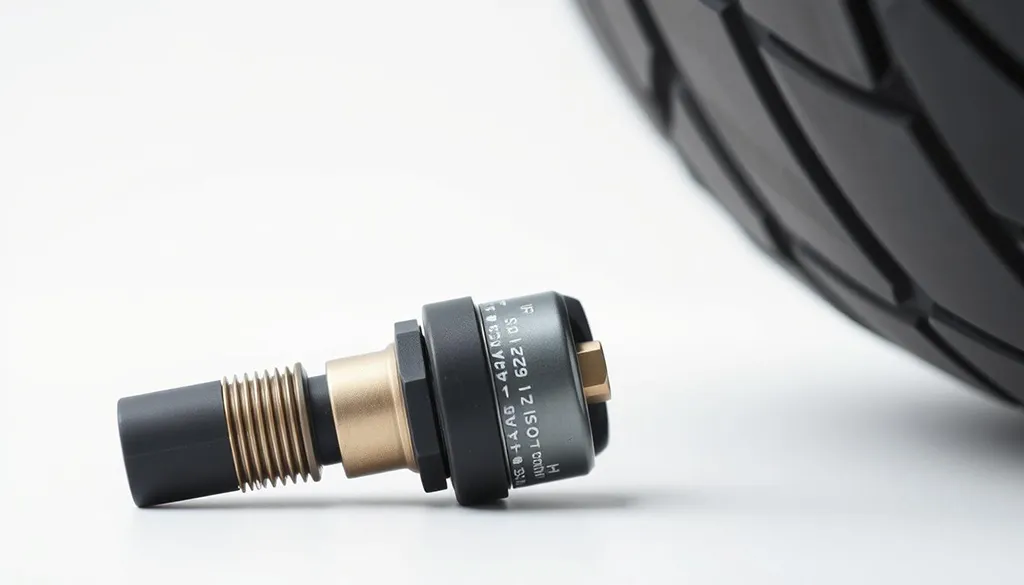
TPMS Sensor Installation Cost
Knowing these costs helps me make smart choices about my vehicle’s tire pressure sensors. I can balance safety and budgeting effectively.
Top Picks for Tire Pressure Sensors
Finding the right tire pressure sensor can be tough. But, choosing wisely can make your vehicle safer and perform better. Here are my top picks for the best direct and indirect TPMS options. I’ve picked them based on reliability, user feedback, and performance. This way, you can find the perfect tire pressure sensor for your vehicle.
Best Direct TPMS Options
- TireMinder System: This model costs $99.00 and can check up to 5 tires at once. It comes with a one-year warranty, making it a great direct TPMS choice.
- EEZTire System: Priced at $269.00, it supports up to 22 tires and has a three-year warranty. Its wide monitoring range makes it a top direct TPMS option.
Best Indirect TPMS Choices
- Gozens Tire Pressure Monitor: At just $8.90, this monitor is easy to read. It shows green for correct pressure, yellow for air loss, and red for significant loss. It’s a great indirect TPMS choice.
- Fullele Wireless System: This Amazon best-seller costs $56.07 and monitors tires 24/7. It’s known for its reliability and ease of use, making it a top tire pressure sensor.
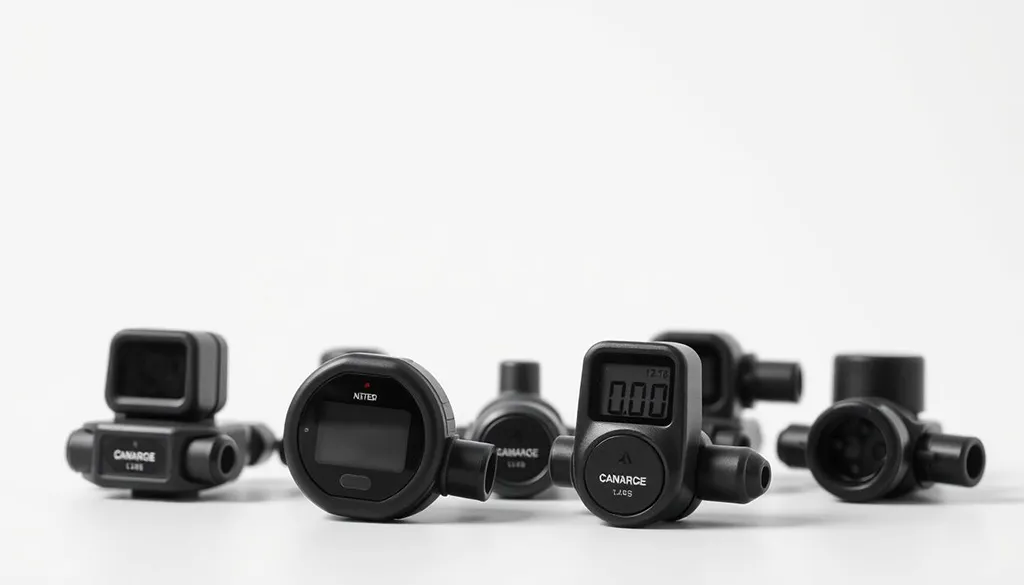
Top Picks for Tire Pressure Sensors
When choosing tire pressure sensors, consider their features and prices. Regular checks keep your tires in top shape. This improves your vehicle’s performance, fuel efficiency, and safety.
Tire Pressure Gauge: An Essential Complement
Tire pressure monitoring systems (TPMS) are key in keeping tires in good shape. They alert drivers to the tire’s inflation level. Yet, a tire pressure gauge is also vital. It gives a manual check of tire health.
Regular checks with a tire pressure gauge confirm if your TPMS is working right. This section explains why a tire pressure gauge is important. It also shows how to use it well.
Why Use a Tire Pressure Gauge Alongside TPMS
TPMS alerts us to under or over-inflated tires. But, relying only on it might make us too confident. A tire pressure gauge lets us double-check the readings.
Even small drops in pressure can harm fuel efficiency and tire life. A tire pressure gauge quickly checks if tires are at the right PSI. This ensures they perform well and safely.
How to Use a Tire Pressure Gauge Effectively
Using a tire pressure gauge is easy. Here’s how to do it:
- Check tire pressure when tires are cold. Driving heats them up, raising pressure.
- Remove the valve cap from the tire you’re checking.
- Press the gauge firmly onto the valve stem for a tight seal.
- Read the gauge and note the PSI.
- If it’s low, inflate to the right PSI. If it’s high, let some air out.
- Put the valve cap back after checking.
By adding tire pressure gauge checks to our routine, we can better use TPMS. This keeps tires properly inflated for safer driving.
Maintenance Tips for Tire Pressure Sensors
Keeping tire pressure sensors in good shape is key for safety and performance. Regular checks ensure they work right, avoiding unexpected issues. Here are some tips to keep your tire pressure sensors in top condition.
Regular Checks and Resetting the TPMS
Regular checks are vital for your tire pressure monitoring system (TPMS). Check tire pressure monthly, before long trips or heavy loads. This helps prevent tire wear and tear from underinflation.
The TPMS alert light shows when tire pressure is off. Temperature changes can also trigger the light. If the light blinks during startup, get it checked quickly to fix any problems.
Protecting Sensors from Damage
Keep TPMS sensors safe during tire changes or maintenance. Have pros handle reprogramming or relearning to avoid sensor failures. Spare tires left unused can cause false readings, making sensors unreliable.
Use a dedicated TPMS tool for quick and easy reprogramming. This keeps your vehicle running smoothly and efficiently.
| Maintenance Task | Frequency | Notes |
| Check Tire Pressure | Monthly | Prior to long trips or when carrying heavy loads. |
| Inspect TPMS Light | Every Start | Pay attention to blinking lights at startup. |
| Reprogram/Reset TPMS | As Needed | After tire changes, rotations, and repairs. |
| Replace TPMS Sensors | Every 7-10 Years | Consider simultaneous replacement if one fails. |
| Use Dedicated TPMS Tool | When Servicing | Helps in efficient reprogramming and reduces downtime. |
Conclusion
Tire pressure sensors are key to vehicle safety. They check tire pressure and prevent accidents from under-inflation, which can cause blowouts. Keeping the right tire pressure improves fuel efficiency by up to 3%.
TPMS does more than just monitor. It helps extend tire life with regular checks and adjustments. This avoids unnecessary wear and maintenance costs. It also reminds us to stay on top of tire care.
Choosing reliable TPMS technology is a big deal. It’s not just about maintenance; it’s about being a responsible car owner. These systems are vital for keeping our vehicles safe and efficient.
FAQ
What is a tire pressure monitoring system (TPMS)?
A tire pressure monitoring system (TPMS) is a safety feature in vehicles. It checks the air pressure in the tires. It alerts the driver if it’s too low, helping prevent accidents.
How often should I check my tire pressure?
You should check your tire pressure at least once a month. Also, before long trips. This ensures your tires are inflated right for safety and performance.
What are the signs that my tire pressure sensors need replacement?
Signs include a warning light on the dashboard for low pressure or sensor failure. Also, unusual tire wear or consistent wrong readings.
How do I replace a tire pressure sensor?
First, remove the tire from the wheel. Then, replace the old sensor with a new one. Make sure the new sensor is calibrated and the system is reset for accurate readings.

